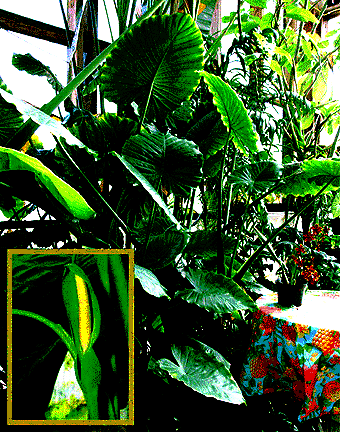![]()
Aroids and other genera in the Collection
Take the Tour Now?
Orchids
The
Exotic Rainforest
Plants in
the Exotic Rainforest Collection
Images on this website are copyright protected. Contact us before
attempting to reuse.
New:
Understanding, pronouncing and using
Botanical terminology, a Glossary

Alocasia gageana is commonly used as a landscape plant in tropical portions of the US including South Florida. A native of Malaysia, the plant is very similar to Alocasia odora which is much larger and a native of Vietnam and perhaps southern China and Burma.
A. gageana produces a thick stem (trunk) that can easily reach several inches thick. The stems of most of ours are between 2 and 3 inches (5 to 8cm) but I have seen the same plant grow much thicker when grown outdoors instead of in an atrium. The plant often grows with very shallow root systems and can easily be pulled from the ground if the soil is loose and well drained.
The leaf size depends on which variation you are growing. The larger has leaves well over 18 inches (46cm) and some internet sites claim they can get as large, or larger, than Alocasia macrorrhiza. That would be big (5 to 6 foot or 150cm to 180cm leaves)! That is really big, which makes me more than dubious! Alocasia species are known to be highly variable and not every leaf of every specimen will always appear the same. This link explains in greater detail the scientific principle of natural variation and morphogenesis. Click here.
During the late summer, once the plant has had most of the growing season to mature, the leaves often reach 2 feet (60cm) plus. The same websites say the plant has to be quite old to obtain a truly massive size. The largest we have ever seen the plant is close to 8 feet (240cm) tall.
Another cultivar more commonly used in landscaping is substantially smaller and rarely grows more than 4 feet tall (120cm) with 15 inch (38cm) leaves. Regardless, both can grow in quite thick clumps and rapidly produce offspring. The plant reproduces by producing "pups" at the base of mature plants or from seed.
A spathe about 2 1/2 to 3 inches (6 to 8cm) tall grows from the plant each spring (see inset). The spathe and spadix are an inflorescence rather than simply a flower. The inflorescence is a complex of tiny male, female and sterile male flowers and a good magnifying glass must be used to see them due to their size. As the spathe matures it turns whiter before it dies and then produces bright red berries which contain seeds. Alocasia gageana makes a great "elephant ear" for a tropical look in non-tropical climates, just bring them in for the winter. The species prefers a mixture of filtered sunlight and shade and enjoy having their "feet" wet. Water this plant frequently.
"Elephant Ear" is a poor term to use to describe any plant species. That term is used to describe plants from numerous genus including Alocasia, Xanthosoma, Philodendron, Anthurium, Caladium, and Colocasia. Those groups represent between 4000 and 5000 plants! So when someone describes an "Elephant Ear", the first question would be, which one of the 5000 species would you like to know about?
Looking for information about "Elephant Ear" plants?
Aroid Pollination!
As
it occurs in nature and by any horticulturist
Join the
International Aroid Society:
http://www.exoticrainforest.com/Join%20IAS.html